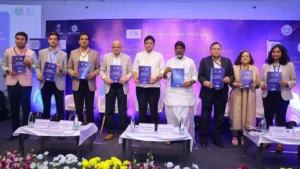The ICC Cricket World Cup 2023 is in full swing, with the top teams vying for a spot in the semifinals. India, South Africa, and Australia have already qualified, while the remaining two spots are still up for grabs. India is currently leading the points table with 16 points, followed by South Africa with 14 points and Australia with 12 points. New Zealand is in fourth place with 10 points, followed by Pakistan and Afghanistan with 8 points each.
England, Bangladesh, Sri Lanka, and the Netherlands are all out of contention for the semifinals. However, they will still be looking to finish the tournament on a high and improve their ranking.
Australia Wins Cricket World Cup 2023
ICC ODI Cricket World Cup 2023 Winner has been decided on 19th November 2023 when the two best teams of the tournament faced each other in Narendra Modi Stadium Ahmedabad (India). Australia became the new World Cup 2023 winner by defeating India in the final match. In the final match, India played first and scored 240 runs, after that Australia chased the target by in 43 overs with loss of 4 wickets. Australian opener Travis Head became the Man of the Match in the final match. He scored 137 runs in 120 balls with 15 fours and 4 sixes. India batter scored most runs in this tournaments. India pacer Mohammed Shami took most wickets in World Cup 2023 with 24 wickets in 7 matches.
The first semifinal match was played between India and New Zealand in Mumbai on 15th November 2023 and team India won this match by 70 runs. The second semi-final match was played between Australia and South Africa on 16th November in Kolkata and it was won by team Australia by 3 wickets.
ICC World Cup 2023 Schedule All Matches
ICC Cricket World Cup 2023 – Points Table
ICC World Cup 2023 Points Table show the latest team ranking in the ICC World Cup Group. Now the table has been topped by India with 8 Matches win. This points table show teams, matches, won, lost, tied, net run rate etc.
| Rank | Team | Matches Played | Wins | Losses | Draws | Points | Net Run Rate |
|---|---|---|---|---|---|---|---|
| 1 | India | 8 | 8 | 0 | 0 | 16 | +2.456 |
| 2 | South Africa | 9 | 7 | 2 | 0 | 14 | +1.261 |
| 3 | Australia | 8 | 6 | 2 | 0 | 12 | +0.861 |
| 4 | New Zealand | 9 | 5 | 4 | 0 | 10 | +0.743 |
| 5 | Pakistan | 8 | 4 | 4 | 0 | 8 | +0.036 |
| 6 | Afghanistan | 9 | 4 | 5 | 0 | 8 | -0.336 |
| 7 | England | 8 | 2 | 6 | 0 | 4 | -0.885 |
| 8 | Bangladesh | 8 | 2 | 6 | 0 | 4 | -1.142 |
| 9 | Sri Lanka | 9 | 2 | 7 | 0 | 4 | -1.419 |
| 10 | Netherlands | 8 | 2 | 6 | 0 | 4 | -1.635 |
Points are awarded as follows:
- Win: 2 points
- Tie: 1 point
- Loss: 0 points
Here is a simplified explanation of the ICC World Cup 2023 Points Table
- Each team plays each other once in the group stage.
- Teams are awarded points for winning, tying, and losing matches.
- The top four teams in the points table at the end of the group stage qualify for the semi-finals.
- The winners of the semi-finals will then play in the final.
The ICC World Cup 2023 Points Table is an important part of the tournament, as it shows how the teams are performing and who is in contention to win.




 NITI Aayog & IBM Unveil Roadmap to M...
NITI Aayog & IBM Unveil Roadmap to M...
 Weak La Niña Likely to Influence Global ...
Weak La Niña Likely to Influence Global ...
 IFFCO-TOKIO Partners with Cooperatives t...
IFFCO-TOKIO Partners with Cooperatives t...







